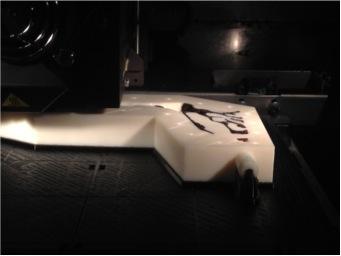

A partially completed 3-D printed airway from nostril to trachea with fine structure of the nasal cavity showing.
Credit: Rui Ni, Penn State
Tasting food relies on food volatiles moving from the back of the mouth to the nasal cavity, but researchers have wondered why airflow doesn't carry them in the other direction, into the lungs. Now a team of engineers, using a 3D printed model of the human airway from nostril to trachea, has determined that the shape of the airway preferentially transfers volatiles to the nasal cavity and allows humans to enjoy the smell of good food.
“During quiet breathing, there is no valve that can control the direction of volatile transport,” said Rui Ni, assistant professor of mechanical engineering, Penn State. “However, something must be controlling the movement of these particles and keeping them out of the lungs.”
In the past, physiologists looked at the nasal passages, but not at the pathway from the back of the mouth to the nose. In this case, the researchers used data from CT scans and the help of two radiologists to build a schematic of the human airway from the nostrils to the trachea, including the fine structure. They then used the schematic to make a 3D model using a 3D printer.
Ni and colleagues then tested airflow into and out of the airway. They reported their results in a recent issue of Proceedings of the National Academy of Sciences.
Chewed food particles end up in the back of the mouth in a sort of side cavity to the main airflow. The researchers found that when air is inhaled through the nose, the air flow forms an air curtain to prevent volatile particles released from the back of the mouth from escaping into the lungs. However, when air is exhaled, it sweeps into the area with abundant food volatiles moving them into the nasal cavity where they are sensed by olfactory cells.
Movement of the particles is also effected by the speed of breathing.
“Smooth, relatively slow breathing maximizes delivery of the particles to the nose,” said Ni. “Food smells and tastes better if you take your time.”
This slow, steady breathing optimizes the unsymmetrical transport effect and allows more air to sweep particles out and up. Ni suggests that for a really good meal, taking time to slow down and breathe smoothly will deliver more smell and flavor.
###
Other researchers on this project included Mark H. Michalski, Gordon M. Shepherd and Elliott Brown, School of Medicine; Ngoc Doan and Joseph Zinter, Center for Engineering Innovation and Design; and Nicholas T. Ouelletter, Department of Mechanical Engineering and Materials Science; all at Yale University.
The National Institutes of Health and the National Science Foundation supported this work.












